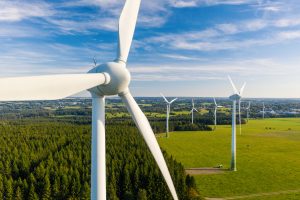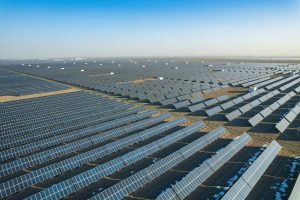Renewable energy’s coming of age

The MSCI Alternative Energy Index (comprised mainly of wind and solar companies and their supply chains) posted an extraordinary 105% in 2020, more than double the Nasdaq’s over the same timeframe (42%). 2020 has seen previous long-term commitments to new
Renewable energy
Looking ahead, the opportunities to take advantage of this sector are only expected to increase. This is in part due to policy initiatives such as the goals established by the Paris Climate Accord to reduce global CO2 emissions to a
Net Zero
A key driver for renewable’s performance has been the rate of growth of agreed wind and solar installations for companies’ order books. We believe this opportunity is still growing but also widening as companies and investors continue to develop their ambitions and business plans. A recent Bloomberg New Energy Finance (BNEF) study captures this, having increased its estimate for the total forecast investments in new energy power generation from $13.1 trillion last year to $15.1 trillion in its most recent update. 3
2020 also saw increasing interest in hydrogen as part of this renewable mix. The European Commission’s Hydrogen Strategy is targeting 40GW of electrolyser capacity by 2030. Additionally, the EU could spend as much as €470bn (£425bn) on hydrogen production by 2050. The UK government has also committed to invest up to £500m in hydrogen initiatives and is aiming for five gigawatts (GW) of low carbon hydrogen production by 2030. With these types of government commitment, interest in hydrogen by investors has increased. Goldman Sachs predicts an addressable market for
Green hydrogen
However, the sector still remains volatile and the production of hydrogen is not without its challenges. None least the need for it to be predominantly green hydrogen, not the
Natural gas
Blue hydrogen
Our view is we’re still in the early stages of the investment cycle and we remain vigilant for the catalysts that will provide further acceleration in this sector. For example, in addition to the European Commission’s Hydrogen Strategy, it is reportedly tabling a recommendation for the EU to take a more co-ordinated approach in bringing more Wind Power online to reach the 300GW of capacity needed by 2050 by promoting more hybrid sites to which more than one member nation can share access. 6
We also believe the policy intention is growing as reflected elsewhere, as the UK government continues to build on its promise to put climate at the centre of its policy agenda. It has also been reported that in the calls President Biden has had with many foreign leaders since the election, climate policy “has been in the heart” of these conversations. 7
It might be tempting to give
Credit
There is also the employment imperative. In the US, the outgoing Republican administration has been strongly influenced by the fossil fuel lobby, whose narrative is that to reduce oil and gas investment would threaten US prosperity and jobs. However, the figures tell a very different story. As the Clean Jobs in America report highlights, of the 8.4m US workers in the energy sector, nearly three times as many work in renewables vs fossil fuels, and in terms of new jobs created in 2019, the multiplier rises to more than four times. 9 There is some cause for optimism therefore, that regardless of which party controls the US Senate for the next two years, there could be bi-partisan support for further increases in green energy infrastructure spending because of the wide employment benefits to the US.
As we look ahead, we see significant further investment potential in renewable power generation, the age of renewable here and the opportunities available only look set to increase.
Footnotes
- Scroll to footnote
- Scroll to footnote
-
MSCI and Bloomberg data to Dec 31st 2020Scroll to footnote
- Scroll to footnote
- Scroll to footnote
- Scroll to footnote
- Scroll to footnote
- Scroll to footnote
- Scroll to footnote





